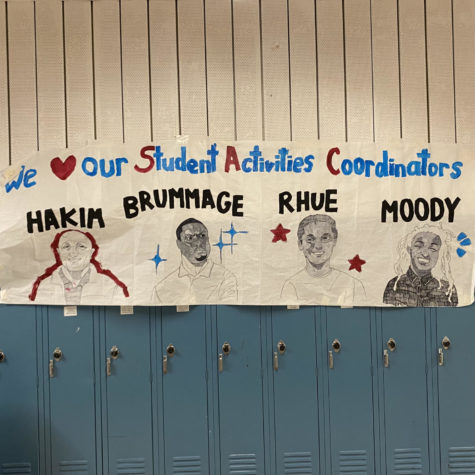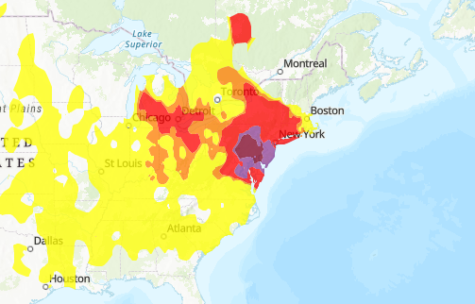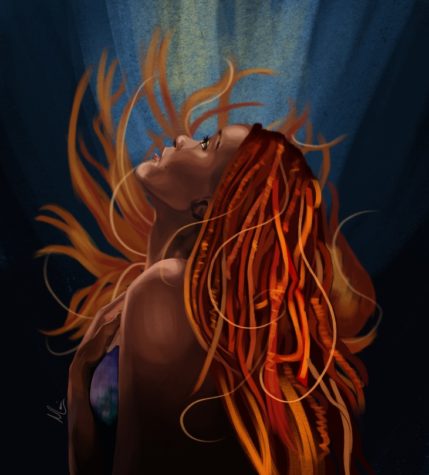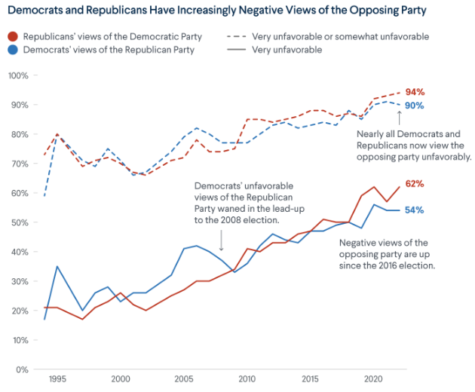A lesson on internet etiquette: What we can learn from the Covington situation
February 12, 2019
By John Kibler
By now, you have likely seen the video. A white high schooler wearing a ‘Make America Great Again’ hat, face-to-face with a Native American elder passively chanting and playing a drum. The boy’s face wearing a demeaning smirk, he was surrounded by nothing but other white, conservative kids in MAGA hats mocking the elder and getting down to the drumbeat, like they did the last time they chose “Mo Bamba” over “Sicko Mode.”
Upon seeing this 10-second clip of the boys aggressively surrounding the elder, I felt sick to the stomach, as anyone who has any level of a moral compass would. The first reply that I saw under the tweet exposed the young man’s identity as Nick Sandmann, along with his mother’s occupation and employer. The students attend the private, all-male Covington Catholic High School in suburban Kentucky. I copied the information onto a sheet of notebook paper, “for future reference.”* They need to learn the consequences for acting in this degree of hate, don’t they? Their parents certainly won’t teach them correctly.
Shortly after Twitter exploded, another two-hour video surfaced which was filmed from the perspective of another group present on the steps of the Lincoln Memorial. The Black Hebrew Israelites, who firmly believe that those of African descent are the literal descendants of the biblical Israelites, were shouting insults at everyone within earshot.
“You worship the eagles,” the speaker of the group said to the Native American group. “You worship the Phoenix. You worship the Buffalo! What do you think that’s speaking of?…How’s a buffalo going to save you? You eat a buffalo. You wear a buffalo.”
He then described one of the marchers as a “$5 Indian.”
There were some remaining patches of snow still remaining on the ground. D.C. can sure be cool in the winter, but not as cool as the guy riding the One Wheel skateboard in circles around the Black Israelites.
“Come closer, you gon’ catch this,” said the speaker of the Black Israelites, missing a spit attempt as the skateboarder was showing off. “In a new kingdom, this man’ll get his head cracked to the white meat….His blood will be on his skateboard and his shoes.”
“As soon as he gets too close, I’m gonna knock him off that jaunt and I’m gonna [mess] him up,” said the one filming the video. Flex on, skater boy.
Upon seeing the group of Covington Catholic students gathering on the steps to await their bus, he didn’t hesisitate to call them “incest babies.”
“If this the best nation, why y’all can’t get rid of lice season? If y’all the best nation, get rid of that damn lice on y’all back!” Truly words of wisdom.
Covington started school chants—it was a little obnoxious, but hype nonetheless—and this is when Native American activist Nathan Phillips misread the situation and perceived hateful ambitions among the boys. He walked up slowly, in a non-confrontational manner, contrary to what numerous right-wing influencers have said.
Without a doubt, the Covington Catholic High School boys acted disrespectfully toward Phillips. That is highlighted by the 10-second viral video, and most people saw only those 10 seconds of the situation. Of course, the video spiked hateful feelings in that majority, who doesn’t know the entirety of the story. I cannot blame them.
But the actions of these boys are also completely understandable. They obviously felt attacked; who wouldn’t, when someone is shouting things like “incest-child” at them? Their school chants, which were supposedly meant to drown out these verbal attacks, were a good idea in theory but only ended up making a dangerous atmosphere of pride mixed with fear. They acted in the moment, making it difficult for any outsider (or even the reflecting participants) to understand their motives.
Meanwhile, underage Nick Sandmann has become a national symbol of white privilege and modern, supremacist racism. This is something that will stick with him forever, likely affecting his college acceptances and job hirings. He even has a profile on wikioffical.com, where his age, ethnicity, education, parents and parents’ occupations are listed. Those who exposed this information were likely also acting in the moment, not even knowing half of the story, but instead of fear and pride they felt purely hate: the most dangerous sentiment.
Professor Semir Zeki of University College London studied the neurology of subjects who see the familiar face of someone who they do not like, and identified a ‘hate circuit’: a collection of areas that become highly active and mobilize aggressive behavior while hateful feelings are present. Uncoincidentally, the two most significant areas of this brain (putamen and insula) also come into effect upon feelings of romantic love.
Both are arguably the strongest emotions that one can face, and have nearly identical—in a different context, granted—behavioral reactions: aggression, whether it be spiteful or romantic and sexual, a lack of proper judgment and reasoning, and general situational distress. It is important to understand that these reactions are instinctive, and have underestimated control over us.
AP psychology teacher Kristina Berney helped to analyze the situation and the impulsive reactions by the media. There are a number of social psychology concepts that factor into both sides of such a situation, but in this case they center around prejudice.
These students were the stereotype of a young Trump supporter, wearing a hat that has become a symbol of neoconservatism along with anything one might find unsettling about the political far right. As soon as many viewers saw the first frame of the video, they recognized the crowd of white teenagers wearing those hats, and immediately judged the situation before anything took place. This sort of pre-judgment is completely natural as political parties become increasingly polarized, and the ingroup-outgroup bias starts to take place in American politics
“People that might have been conservative might have been less likely to blame them versus those who were liberal,” said Berney, “because [liberals] are going to view them as the outgroup so they’re going to be very quick to condemn…They’re going to judge them more harshly because they’re part of the outgroup, not the ingroup.”
If you’re into team sports and you have ever felt any hostility towards the opposing team, then you have fallen victim to this bias. Especially in the last 50 years, American politicians have given the sense of “us versus them,” which only plants more of this hostility in our society.
Concerning the misunderstandings on social media and the one-sided representation, it is obviously difficult to judge any situation from a short clip. Seeing Sandmann’s demeanor, we were quick to assume it was a product of his personal prejudices multiplied by that of his classmates. This is known as the fundamental attribution error: underestimating the environmental impacts on someone else’s actions.
“With the fundamental attribution error,” said Berney, “we tend to judge other people’s behavior off of their disposition (something internal, like who their personality is) versus situational factors. We saw this in that incident because people just assumed that those kids were behaving that way, because they were obnoxious, rude kids, without recognizing the situational factors that preceded it, which once the full video became adamantly clear…People understood better why they were behaving that way because of those situational things.”
In the short while after the first clip went up, the dispositional perspective was all that the internet had. It was all we needed to confiscate Nick Sandmann’s privacy, to find his personal information, and to threaten his own, his family’s, and his school’s safety.
Recently another image went viral of a basketball game held at Covington, a “black-out” game where the students are encouraged to wear all black for school spirit. It’s the same concept as PA’s “white-out” games, except we use a different color because, as teenagers with underdeveloped frontal lobes, there always has to be that one person who wears blackface to a black-out. Except at Covington, there were four students wearing blackface in a photograph of about 20 spectators. Judging by videos of the school’s basketball games, and by the school pride at this particular game, the gymnasium was packed.
High school basketball player Phillip Hawkins played Covington in 2015, and was interviewed about it by Inside Edition.
“They chanted ‘ca-ra-mel, ca-ra-mel,’” said Hawkins, “and as the only black kid on the floor, you knew who they were talking about.”
Now, we can confirm from multiple sources that these guys are bullies. Does that justify intense harassment of a minor on social media? Of course not. Their actions are still understandable, and they were attacked by another group. Bullies will be bullies. We cannot get rid of them.
These are not the type of people I would want to become acquainted with. They are unexperienced and are not fully able to make fully informed decisions. But they are still high schoolers regardless. They have a long life ahead of them, and they come from a sheltered, male private school. And as the reader, you may also still be a high schooler who still has much to learn. So please, have some decency.
“We talk a lot in psych about the enlightenment effect, and how once you’re aware of psychological concepts you’re less likely to fall victim to them,” said Berney, referencing efforts to have some self-control. “Even for myself, as a teacher who’s been teaching this for over a decade, that impulse is still there…Sometimes it’s not an error, sometimes it is just a bad person. But recognizing that there’s a lot of situational things that might possibly explain and trying to point out to other people…It’s not an attempt to necessarily justify, but to better understand why someone did what they did.”
With an abundance of biased reporting and conspiracy theories that are often taken far too seriously, it’s easy to see the effect that the internet on our perception of reality and dictate how we react to certain situations. During the 2016 presidential election Pew Research Center reported that over 80 percent of respondents say that Donald Trump supporters and Hillary Clinton supporters could not agree on the reality of “basic facts.” The influence that the internet has on our minds is becoming increasingly frightening, and one of the most recent manifestations of this is Twitter’s reaction the the behavior of the students from Covington Catholic High School.
In this age, as hardly any interaction can escape the influence of political allegiances, and an anonymous but boisterous identity becomes increasingly accessible, it’s becoming more imperative than ever to mediate any immediate spite that is felt in any distressing situation and to consider others’ right to privacy. The students at Covington Catholic may not have the most attractive personas, but letting negative emotions take control of people is never healthy, specifically when they only see one side of the story.
*That paper is now ripped up and in the trash.
Zeki’s study:
University College London. “Brain’s ‘Hate Circuit’ Identified.” ScienceDaily. ScienceDaily, 29 October 2008. <www.sciencedaily.com/releases/2008/10/081028205658.htm>.
Pew Survey:









Rähn Sækerr • Feb 14, 2019 at 9:42 pm
Now, if there’s anything I’ve ever heard way too many times regarding modern society, it is that “you shouldn’t believe everything you hear on the internet.” I always saw this as a tad dumb, because of course, no rational person out there would actually think otherwise. However, and I’d hate to parrot everything that has already been said before, but whenever there seems to be an outcry in the media when race is brought up into things, everybody always sticks to one side: that “the person of color is oppressed and the white man is guilty.” This is one of those scenarios, and I doubt Sandmann’s actions would be any different if Phillips was just another white American with an electric guitar singing “We Will Rock You” directly in his face; either way, walking up to someone while continuously playing any kind of music, drumbeat or guitar solo, would spark confusion and awkwardness; one of the responses to such emotions would include just standing there with the friendliest of expressions anyone could attempt to pull off: a smile, even when that smile might’ve been misconstrued as demeaning. When Phillips reaches out to the media, pushing a false narrative of what happened, this is when the double-standard becomes apparent, and the Covington situation makes a good case on why you shouldn’t trust not only everything you hear on the internet, but you should also question everything you hear in the media or on the news. Not only that, but to think this man and his family’s private info was leaked on the internet and that they were sent death threats, all because of a few people capturing a video of a him standing still while his accuser kept beating a drum right in front of him, is agreeably where people start losing their minds. It redeems my hope in the world that that there are people like you who make up your mind and think twice before forming a rational opinion on such matters. In fact, John, I think you’d make a better journalist than most others whose articles I’ve seen. You’ve earned my respect for looking at this case with a skeptical eye, and I certainly applaud you for not believing everything you hear in the media.
Sincerely,
Rähn Sækerr